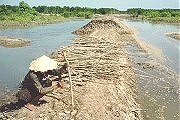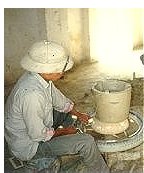

Vietnam 
 |
Wood Energy Situation Policies and Programmes Wood Energy Data Further Reading RWEDP Focal Points |
Wood Energy Situation
Vietnam is a relatively small producer and consumer of energy. The country, however, has large energy reserves, consisting of extensive coal deposits, gas, peat and considerable and widespread hydropower and biomass resources. Biomass fuels such as fuelwood and agricultural residues are the major source of energy used by the vast majority of the rural and semi-urban population. In 1994, wood energy consumption was 423 PJ, accounting for 39% of total energy consumption. A large amount of fuelwood is used for the preparation of pig feed, which is almost always cooked.
Data on wood energy is still limited in Vietnam. There are indications that severe woodfuel scarcities exist, particularly in the hills, but also in delta areas. Shifting cultivation by seven million people from the ethnic minorities is blamed for deforestation. However, RWEDP has observed that annual deforestation is about equal to the annual increase in agricultural land.
Policies and Programmes
The Government of Vietnam has designated the as the main implementing agency for RWEDP. The National Committee on Wood Energy Development associated with FSIV will establish the links with other sectors and organisations. The secretary/member of the National Committee on Wood Energy (NATCOM) who is with FSIV intends to (re-) establish NATCOM in line with RWEDP objectives. Prospective members of NATCOM are: FSIV (also representing the Ministry of Forestry), representatives of the Ministry/Institute of Energy, the Ministry of Science, Technology and Environment, the State Planning Committee, etc. In due course the Ministries of Forestry and Agriculture (and Irrigation) will merge into one ministry, which will facilitate co-operation.
 A pilot project for the dissemination of space-heating stoves has been implemented by the Forest Science and Technology Application Centre of the Forest Science Institute of Vietnam (FSIV) and it stipulated that technical advice would be obtained from Institute of Energy (IE). IE, being the main policy organisation for the Ministry of Energy, focuses on planning and policy development in the energy sector. Most of the attention is being directed to the modern energy sector, including electricity. Efforts are being made to encourage the substitution of biomass by coal in the household sector, which is successful in Hanoi. However, the transition has major adverse health impact, because coal has a high sulphur contents. IE enjoys many relevant international contacts and co-operation, and is active in a variety of renewable energy technologies. Two years ago IE proposed that the Government address biomass energy in its policies. By the end of 1995, the institute published a document, "Vietnam Energy Review", which is the result of a study on energy supply and use, including rural energy. However, the section on rural energy was rudimentary since data was available only for northern parts of the country. The intention of the Government of Vietnam is to proceed with rural energy planning, including wood and biomass energy, with assistance from the Asia Development Bank. Full results on rural energy are expected after a 3-year period, leading to a Vietnam Rural Energy Review.
A pilot project for the dissemination of space-heating stoves has been implemented by the Forest Science and Technology Application Centre of the Forest Science Institute of Vietnam (FSIV) and it stipulated that technical advice would be obtained from Institute of Energy (IE). IE, being the main policy organisation for the Ministry of Energy, focuses on planning and policy development in the energy sector. Most of the attention is being directed to the modern energy sector, including electricity. Efforts are being made to encourage the substitution of biomass by coal in the household sector, which is successful in Hanoi. However, the transition has major adverse health impact, because coal has a high sulphur contents. IE enjoys many relevant international contacts and co-operation, and is active in a variety of renewable energy technologies. Two years ago IE proposed that the Government address biomass energy in its policies. By the end of 1995, the institute published a document, "Vietnam Energy Review", which is the result of a study on energy supply and use, including rural energy. However, the section on rural energy was rudimentary since data was available only for northern parts of the country. The intention of the Government of Vietnam is to proceed with rural energy planning, including wood and biomass energy, with assistance from the Asia Development Bank. Full results on rural energy are expected after a 3-year period, leading to a Vietnam Rural Energy Review.
The Research Centre for Architectural Indoor Climatology and Environment of the Hanoi Architectural Institute (HAI) is involved in researching the links between improved kitchen design and wood energy stoves. Such links are particularly important when the latter could help with space heating. The long-standing co-operation of HAI and Lund University in this subject is ongoing.
Wood Energy Data
| General | |||||
| Population (1996) | 75.2 mln. | ||||
| Share of Rural Population | 79.0% | ||||
| GDP per capita (1995) in constant 1987 US$ | 865 | ||||
| Energy Consumption (1995) | |||||
| Total Final Energy Consumption in PJ | 1,083.6 | ||||
| Consumption of Wood Energy in PJ | 444.5 | (41.0%) | |||
| Consumption of Biomass Energy in PJ | 842.3 | (77.7%) | |||
| Wood Energy Resources | |||||
| Forest Area (1995) in 1000 ha | 9,117 | (28.0%) | |||
| Natural Forest Area (1995) in 1000 ha | 7,647 | (23.5%) | |||
| Agricultural Area (1994) in 1000 ha | 7,086 | (21.8%) | |||
| Share of Woodfuels from Forest Areas | NA | ||||
| Potential Wood Energy Supply (1994) | |||||
| Sust. Supply from Natural Forest in kton | 10,814 | ||||
| Sust. Supply from Forest Plantations in kton | 5,128 | ||||
| Sust. Supply from Agriculture Areas in kton | 7,396 | ||||
| Sust. Supply from Other Wooded Land in kton | 7,124 | ||||
| Supply from Wood Waste from Deforestation in kton | 18,498 | ||||
| Total Potential Supply in kton | 48,960 | ||||
| Primary Wood Energy Requirements in kton | 29,368 | ||||
Notes:
Population and land use data from FAO (FAOSTAT), GDP per capita from World Bank. Energy consumption data from various sources.
Potential wood energy supply estimated by RWEDP, based on available data for land use, wood productivity and estimates on availability of wood for energy use. For forest land, other wooded land and agriculture areas, the potential supply is based on average annual yield estimates, assuming a sustainable use of resources (Sust.: sustainable). Wood waste from deforestation refers to wood potentially available from natural forest land cleared due to commercial logging, expansion of agriculture land or other reasons. The estimates are based on aggregated national data, which can hide local variations, ranging from scarcity to abundance. For detailed calculations and estimates for 2010, see FD50, chapter 8
Further reading:
| Regional Study on Wood Energy Today and Tomorrow in Asia, Field Document 50, 1997 | |
| Chapter 2 in Review of Wood Energy Data in RWEDP Member Countries, Field Document 47, 1997 | |
| Biomass Energy in Asean Member Countries, 1997 | |
| Summary Report of National Training Course on Woodfuel Production and Marketing in Forest, Agriculture and Tree Production Systems, Hanoi, Vietnam, RWEDP Report 27, 1996 | |
| Mangrove for Production and Protection, A changing Resource System: Case Study in Can Gio District, Southern Vietnam, Field Document 43, 1993 | |
| Tropical Forestry Action Programme Vietnam, Fuelwood and Energy Sectoral Review, Field Document 33, 1992 |
Focal points are the main contacts for RWEDP in a member country. Generally, in each country, there is one focal point in the energy sector, and one in the forestry sector.
| Director Forest Science Institute Vietnam Ministry of Forestry Chem - Tu Liem Hanoi TEL: 84-4-8362257 FAX: 84-4-8345722 | Deputy Director Institute of Energy Ministry of Energy Khoung Thoung, Dong Da Hanoi TEL: 84-4-63730/62454 FAX: 84-4-523311 |
Comments, questions? webmaster@rwedp.org
© FAO-RWEDP, 1999